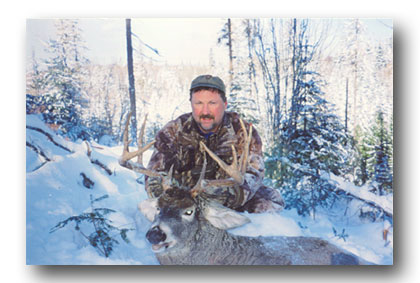
By Longwalker
Pacific Northwest Field Editor

The 2002 season had some of the toughest conditions imaginable for serious whitetail hunters. Not a flake of snow fell in most whitetail habitat, yet with subfreezing temperatures the cold weather caused the ground to freeze hard as a rock — not very conducive for tracking or patterning mature whitetail bucks. Consequently more bucks escaped and there were more mature bucks available for North Idaho Nimrods in 2003.
Snow began falling and sticking midway through the general season in 2003, which was the entire month of November. Just prior to Thanksgiving, during the peak of the rut, I was cruising the edges of a new clear-cut in my home bailiwick. Knee-deep powder snow made the going a bit tough but virtually noiseless. Several inches of the beautiful white fluff had fallen during the night and a light snow continued to fall as I set out at first light. By cautiously still-hunting into the wind, I was able to approach several bunches of deer that morning.
Nearly every knot of does and fawns I encountered were completely engrossed in browsing. It was clear that the previous night’s storm had kept these deer "pinned down" and they were now willing to move freely during the coming daylight hours to keep their furnaces stoked.
The largest dominant bucks would of course be off in the company of one single estrus doe. No mature doe ready to receive her sire would have her fawns at her side this time of year.
All of the sign passing beneath my feet showed that the bucks were completely off their feed and doing nothing but hard traveling in search of a receptive mate. Long strides and large tracks were seemingly everywhere. I was hopeful.
Full daylight and midmorning found me halfway through my swing, slipping silently around a finger where I could look into a little draw with a stringer of fir timber that had been left by the logging operations.
As the head of the draw came into view, I peered into the openings in the timber and spotted a huge scrape. The tracks and deer trails spiraled away from this bare spot in the snow like the spokes of a wheel. Even from 150 yards it was easy to discern that this was obviously a primary scrape. "Shoulda been here at first light," I was thinking.
My thoughts were quickly interrupted by one very loud deer snort objecting to my presence. Out of the top of this little whitetail Shangri-la exploded a large heavy-bodied doe with a good buck hot on her heels. I threw up the old-hand-worn 8x32 Zeiss binoculars as she led him through the openings in the last of the red firs.
As they came clear of the trees I could see that he, while not a monster, was a good, mature 5-point buck, a bit wider than his ears. I quickly decided that he was just tooooo big to let walk. Besides, if the ground shrinkage was unacceptable, I could always purchase one of the leftover unsold nonresident extra deer tags and keep looking.
That smart old doe wasted no time in increasing the distance between her and myself, pulling my prize along with her over the rise into the next draw. Without time to set up my sticks, I knelt and shot at 200 yards. The first round hit him a bit low in the chest but broke both legs. Even though mortally hit, still he persisted, instinctively pursuing his mandate to procreate. He propelled himself forward with his hind legs, leaving a toboggan like track in the snow. A follow-up shot behind the front shoulder sealed the deal.
He was an older buck. Ears battered and split, teeth worn to the gumline, his better ruts were behind him. With the way winter was already stacking up, it appeared that this very well would have been his last. Even with his neck fully swelled, his hide covered declining muscles and bones. We had already taken younger bucks here, in their prime. Although smaller in stature, they outweighed this old warrior by 40 pounds.
Although his antlers were on the downhill slide, it was the kind of buck that one feels good to have harvested. It was his time to go.
Better a quick death and turned into steaks and roasts, than the long-suffering demise of starvation or hamstrung and pulled down by wolves or coyotes.
Copyright © 2005 J & D Outdoor Communications. All rights reserved.